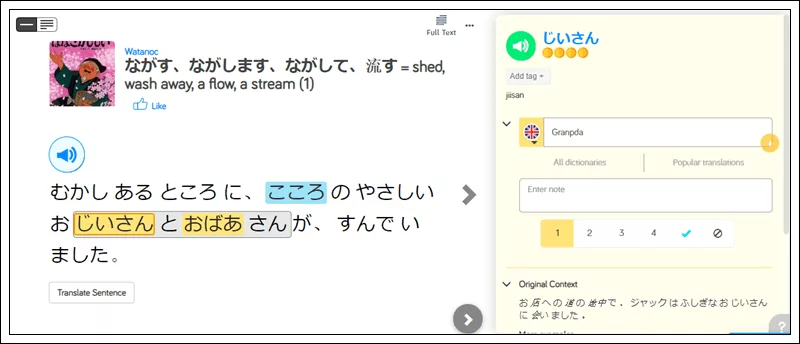Japanese Children’s Stories for Beginners
When it comes to learning Japanese, there is no doubt that reading is one of the hardest skills to master (next to writing). One look at a Japanese newspaper full of kanji is sure to turn many learners away, leaving them questioning just what they have gotten themselves into.
Fear not! There is a much easier way to build up your skills.
Introducing… Japanese children’s stories.
While newspapers and other, more wordy literature can seem intimidating, there’s no need to delve into them right away. In fact, I recommend building up your skill and confidence gradually by starting out with easy-to-read content.
In this article, I will introduce some of the best online resources for finding such stories, and how you can use them to build up your reading skill!
Useful Vocabulary
When navigating these sites (or searching on your own), chances are you will encounter some resources that are written in Japanese (as many are intended for Japanese parents of young children). As such, you will find it helpful to know some common literature related terms to ease your search (and further increase your vocabulary!)
Study these to recognize them while navigating the sites, or challenge yourself by searching them and checking out what resources come up!
Here are a few helpful words:
童話 (どうわ, douwa): fairy tale; children’s story
絵本: (えほん, ehon): picture book
物語: (ものがたり, monogatari): tale; story; legend
昔話: (むかしばなし): folk tale; legend
おとぎ話: (おとぎばなし): fairy tale; nursery tale
年齢: (ねんれい, nenrei): age (for searching by age group)
~さい (sai): ~ years old
Importing to LingQ!
Keep in mind, you will also want to take advantage of the Import feature on LingQ (available on both the browser site and the mobile app; import instructions here.
LingQ makes it easier for you to read Japanese by allowing you to look up new words and phrases using text-to-speech, save, and review them to grow your vocabulary. You can also store all your content into LingQ making it easier to navigate through your favorite stories and save you time. LingQ is the best way to learn Japanese online because it lets you learn from content you enjoy!

Most of the text-based web pages listed here support the import feature, whereas the interactive apps do not.
LingQ is available for desktop as well as Android and iOS. Gain access to thousands of hours of audio and transcripts and begin your journey to fluency today.
Japanese Children Stories Resources
Traditional Japanese Children’s Stories
Import to LingQ: Yes
This page is a collection of popular Japanese children’s stories, as translated by a fellow Japanese learner himself, Tom Ray, as a part of his own Japanese studies. It is also one of the best resources for children’s stories on the internet available in English, and written by a native English speakers (who surely understands the struggles of learning Japanese himself).
They are simple web pages, all text and no images, so are perfect for those who want to focus on reading practice.
Each story is broken down page by page, beginning with the entire block of unaltered Japanese text, followed by the same text broken down and translated line by line.
There are currently 16 translated stories here, including well known ones such as Momotaro and Kaguyahime.
Fairy Tales and Short Stories with Easy Japanese
Import to LingQ: Yes
This site is great because you can kill two birds with one stone: reading and listening comprehension. Wasabi has a great collection of popular Japanese kids’ stories, and they are put together as actual lessons so you can study while you read.
Lessons include the Japanese script (with furigana) to read along to as you play the accompanying audio file (available at 4 different speeds, so you can work your way up from slow to natural), an English translation, and a vocabulary list.
You can import the text into LingQ, however be aware that because the translations are written alongside the text, you may get some English words thrown into the lesson as well. Just ignore them (or you can manual delete them) and focus on the new Japanese words as you normally would.
When you feel your level has increased enough, you can try reading some youth manga on the same website, here.
Pibo (Smartphone App)
Import to LingQ: No
This app is great if you already have a decent handle on reading easy Japanese, and perfect to challenge yourself by reading stories in their original format with no translations or guidance.
That’s because this app is actually made for young Japanese children. The app is an interactive collection of children’s stories written in hiragana with read-along audio, and each story is categorized by age group (from 1 to 12 years old) so you can choose your level.
However, the app itself is also entirely in Japanese, which is another reason why it is recommended to have a working knowledge of basic Japanese so you can navigate with ease.
Ehon Navi
Import to LingQ: No
This one requires several steps (and some basic Japanese skill to navigate), but it is well worth it.
Ehon Navi is a website where you can not only purchase Japanese children’s books, but read them for free via their app! (In fact, I am mainly recommending this site for the app alone – you’ll see why!)
Free registration is required in order to access the app and stories, but it’s simple – all you need is your email address. After signing up and confirming your account by clicking the link in the confirmation email, you can download the app, and here is where the fun really begins.
(You can download the app by copying and pasting the following into your App Store search bar: 絵本ナビためしよみアプリ)
Once you install the app, you will be required to log in again (last time, I promise!), then you will see an entire directory of Japanese picture books!
Select any story under the 全ページためしよみ tab (“read all pages”) to read the full picture book right on your device! Best of all, it’s free! Though you do have the option to purchase the hard copy story book if you so desire.
Hukumusume
Import into LingQ: Yes (limited)
Hukumusume is another great site for practicing both reading and listening. It has a pretty unique and fun feature where you can choose to either listen to the story through video with English subtitles, or use the 絵本 (picture book) feature to flip through it page by page and read on your own. Each page also has an audio file underneath each image so you can listen along as you read.
http://hukumusume.com/douwa/betu/
Following the above link will take you to their fairy tales directory, where you can select a story and read the entire thing as Japanese text via your browser.
Alternatively, you can select stories from the side menu, which will give you the option to listen along with the text. By clicking the View Story option you will be taken to a page with the full text which can also be imported into LingQ.
Digital EHON Site
Import to LingQ: No
This last Ehon website is not as modern and interactive as some of the above mentioned, but worth checking out for a change of pace and different versions of the same stories. Also, because the website is entirely in Japanese (as are the stories), it’s good practice for learning to read and understand without the help of translations.
It might look a bit confusing at first. Simply click the image of a story you want to read (if you’re not familiar enough with Japanese stories to recognize them by illustration alone, then just choose one at random and surprise yourself – the list isn’t organized in any particular way and does not include titles in the links.)
Alternatively, if you do want to search by title, you can click the bottom left link to navigate to the index.
Once you select a story, you can begin reading it by clicking the top left Next button to flip to the next page.
Aozora
Import to LingQ: Yes
Aozora is where it gets more advanced. While there are not so many children’s stories in the form of picture books, you will find plenty of youth literature (as well as full novels for adults when you reach that level).
The stories are available to open in your browser or on your smartphone, and reads like an actual storybook – right to left. The stories are mostly text only, but much of the youth literature is written with furigana.
The site is entirely in Japanese so here is a quick step by step breakdown to finding what you want:
- On the main page, scroll down a bit and navigate to 分野別リスト.
- On that page, scroll down to the second box labeled 童話書.
- This is where you will find youth literature, by category. (歴史・社会科学・自然科学・産業・芸術、美術・文学).
- Each category is further divided by language, so make sure you choose Japanese on the next page! (日本語文学)
- On the next page is a list of yet more categories. You can play around with them, however I recommend Novels & Stories (914. 小説、物語)
- Finally, you will find the list of literature, categorized by author name (last name, first name).
- When you choose a story, look for the browser link (indicated by a blue button labeled “青空 in Browsers”) and click on it to open in a computer browser (Mac & Windows friendly) or mobile device (smartphone & tablet).
I recommend using this site in one of two ways. The first is, if you already have a story in mind you want to look for, Google the Japanese title and author first, and then search for it on the site (either manually or using the search bar). The second (and my particular favorite method) is simply selecting a story at random and surprising yourself – you never know when you might hit on a new favorite author!
Bonus Resources
Ehon Picture Book Apps
There are also several fun and free picture book apps available on smartphones as interactive stories and games. You can simply search デジタル絵本 (digital ehon) in your App Store and select one.
(A personal favorite is どこどこにげた, where you watch and read along as the story unfolds, and take an active part in the story as you are prompted to touch the screen to look for the missing animals!)
Graded Readers
If you’re serious and want to buy yourself some physical books to study with, you might also want to check out some graded readers. There are a number of them available by level and genre on Tadoku.


